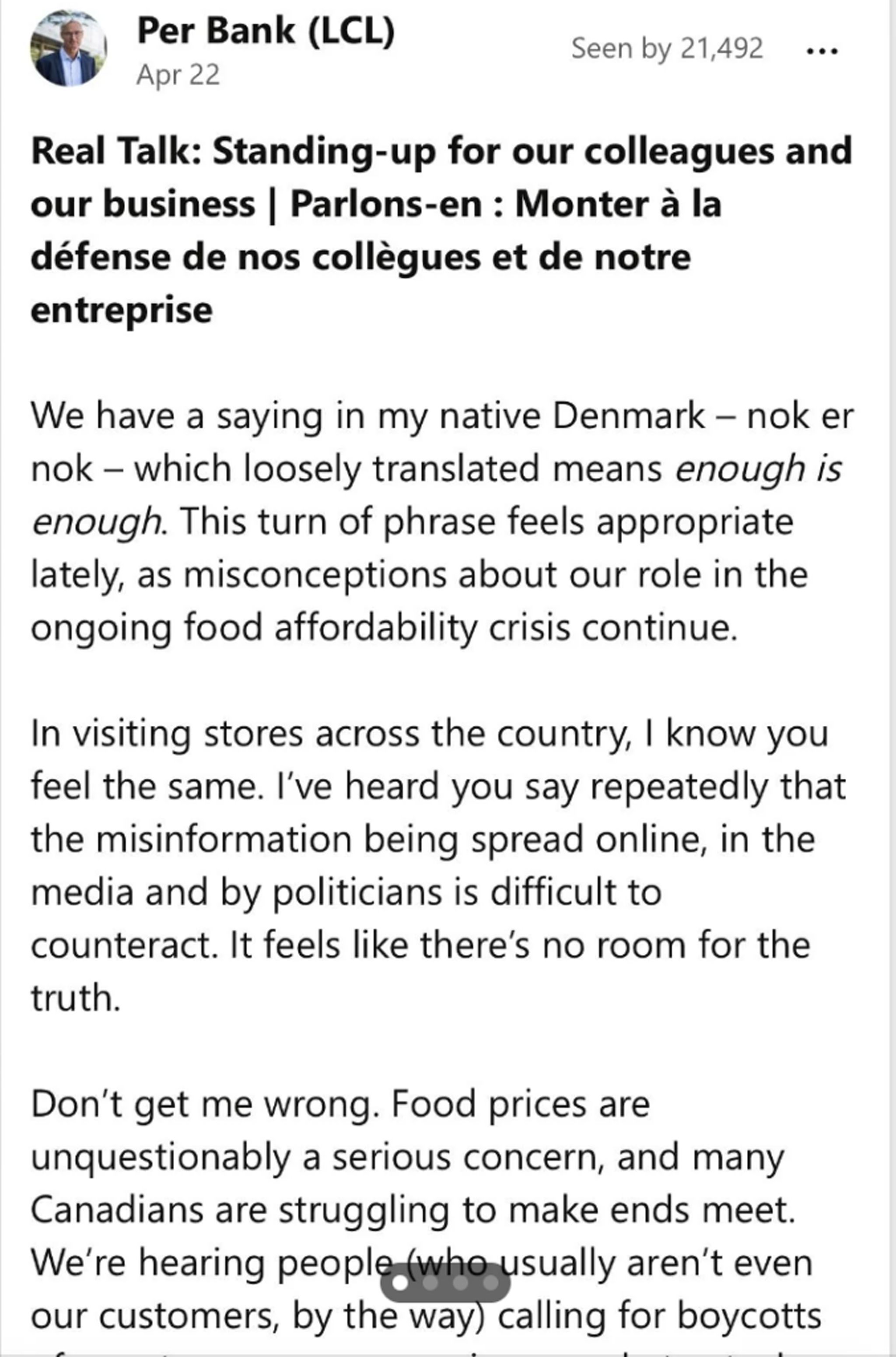Loblaw Adds More Canadian Products, But CEO Questions Longevity Of "Buy Canadian" Movement

Table of Contents
Loblaw's Increased Focus on Canadian Products
Loblaw's commitment to increasing its selection of Canadian products is a significant step towards supporting domestic businesses and the "Buy Canadian" movement. This initiative involves a multi-pronged approach, focusing on both expanding existing product lines and forging new partnerships.
Specific Examples of New Canadian Products
Loblaw has significantly expanded its offerings in several key product categories. The retailer has reported a noticeable increase in shelf space dedicated to Canadian-made dairy products, a category where Canadian farmers and producers play a crucial role. Furthermore, Loblaw's private label brands are increasingly incorporating Canadian ingredients, reflecting a conscious effort to source locally. The company has also partnered with several smaller Canadian suppliers, providing them with crucial access to a larger market.
- Increased selection of Canadian cheeses: Loblaw has added several new varieties of cheese from smaller Canadian creameries to its shelves.
- Expansion of Canadian-grown produce: A wider range of fruits and vegetables sourced from Canadian farms is now available in Loblaw stores.
- Growth in Canadian-made packaged goods: Loblaw's private label brands now feature more Canadian-sourced ingredients in their food and beverage lines. This includes increases in items like pasta, sauces, and baked goods.
- Partnership with local breweries and wineries: Loblaw has expanded its selection of craft beers and wines produced by Canadian breweries and wineries.
Loblaw reports an overall increase of approximately 15% in the percentage of Canadian-sourced products across its stores since the launch of this initiative.
Marketing and Promotion of "Buy Canadian" Initiatives
Loblaw is actively promoting its commitment to Canadian products through various marketing strategies. In-store displays prominently feature Canadian-made goods, using labels and signage that highlight their origin. Loblaw's marketing campaigns also emphasize the company's support for Canadian businesses and the benefits of "Buy Canadian" for the Canadian economy. These campaigns often showcase the stories behind the products and the producers, appealing to consumers' desire to support local businesses.
- In-store signage: Clear and prominent labeling identifies Canadian products on shelves.
- Targeted advertising campaigns: Loblaw is running advertising campaigns highlighting its commitment to Canadian products. [Link to relevant Loblaw press release, if available]
- Social media engagement: Loblaw uses social media to promote Canadian-made products and engage with consumers on the "Buy Canadian" initiative.
The Current State of the "Buy Canadian" Movement
The "Buy Canadian" movement reflects a growing consumer preference for supporting local businesses and the Canadian economy. While the movement has always had supporters, recent economic and social factors have amplified its appeal.
Consumer Demand and Sentiment
Consumer interest in buying Canadian-made goods is demonstrably rising. Several recent surveys indicate a significant portion of Canadian consumers actively seek out and prioritize Canadian products whenever possible. This is driven by a variety of factors, including a desire to support the Canadian economy, concerns about ethical sourcing and sustainability, and a growing appreciation for the quality and craftsmanship associated with many Canadian products.
- Survey by [Source]: [Insert relevant statistics about consumer preference for Canadian products] showing a significant percentage of consumers actively seeking out Canadian-made goods.
- Social media trends: Hashtags like #BuyCanadian and #SupportLocal are increasingly used on social media platforms, indicating a growing consumer awareness and engagement with the movement.
Economic Factors Influencing "Buy Canadian"
Several economic factors influence the success and reach of the "Buy Canadian" movement. The current inflationary environment and fluctuating value of the Canadian dollar both play significant roles. While consumers may desire to "Buy Canadian," affordability often dictates purchasing decisions. The availability of Canadian-made alternatives to imported products is also a key factor. If comparable Canadian products are unavailable or significantly more expensive, consumers may be less likely to prioritize buying Canadian.
- Inflationary pressures: Rising prices make all products more expensive, potentially impacting consumers' ability to prioritize buying Canadian.
- Canadian dollar fluctuations: A weaker Canadian dollar makes imports more expensive, which can indirectly boost the competitiveness of Canadian products.
- Supply chain issues: Disruptions to global supply chains can affect the availability of both imported and Canadian goods.
Government Policies Supporting Canadian Businesses
The Canadian government has implemented various policies and programs to support domestic businesses and foster economic growth within the country. These initiatives play a crucial role in bolstering the "Buy Canadian" movement.
- Tariffs and import duties: The government may levy tariffs on certain imported goods to make domestic products more competitive.
- Subsidies and grants: Government programs provide financial assistance to Canadian businesses, which can help them compete with foreign competitors.
- Investment in innovation: Government funding supports research and development in Canadian industries, promoting innovation and competitiveness.
CEO's Concerns Regarding the Long-Term Viability of "Buy Canadian"
While Loblaw's increased focus on Canadian products is commendable, the company's CEO has expressed valid concerns about the long-term viability of the "Buy Canadian" movement. These concerns stem from the challenges facing Canadian businesses in a fiercely competitive globalized market.
Challenges Facing Canadian Businesses
The CEO's concerns center around the ability of Canadian businesses to consistently compete with lower-priced imports. Scaling production to meet increased demand while maintaining price competitiveness remains a significant hurdle. Additionally, the complexities of global supply chains and fluctuating exchange rates present ongoing challenges.
- Competition from cheaper imports: The cost of manufacturing in Canada can be higher than in some other countries, making Canadian products less competitive on price.
- Challenges in scaling production: Canadian businesses may struggle to increase production quickly enough to meet a surge in demand for their products.
- Supply chain disruptions: Global events can disrupt supply chains, affecting the availability and cost of both imported and domestic products.
The Importance of Price Competitiveness
Price remains a critical factor influencing consumer purchasing decisions. While many consumers express a preference for Canadian-made goods, affordability often plays a crucial role. Canadian businesses need to find a balance between maintaining quality and offering competitive pricing to ensure the long-term success of the "Buy Canadian" movement. Direct price comparisons between similar Canadian and imported products often highlight the price differential which influences consumer choices.
Conclusion
Loblaw's expanded selection of Canadian products demonstrates a commitment to the "Buy Canadian" movement, providing a significant boost to domestic businesses. However, the long-term success of this initiative depends on several factors, including the sustained consumer demand, economic conditions, and the ability of Canadian businesses to remain competitive in the global marketplace. The CEO's concerns highlight the challenges faced by Canadian producers in balancing quality, quantity, and price.
To ensure the longevity of the "Buy Canadian" movement, consumers have a crucial role to play. By actively seeking out and purchasing Canadian-made goods, consumers can directly support local businesses and contribute to the growth of the Canadian economy. Explore more Canadian brands and products today, and help strengthen our local economy by making a conscious effort to #BuyCanadian. Share your experiences and thoughts on the "Buy Canadian" movement—your voice matters!

Featured Posts
-
 Legendary Band Plays Only Under Extreme Circumstances
May 03, 2025
Legendary Band Plays Only Under Extreme Circumstances
May 03, 2025 -
 Unrecognizable Harry Potters Crabbe Now
May 03, 2025
Unrecognizable Harry Potters Crabbe Now
May 03, 2025 -
 Strengthening Productivity The Impact Of Robust Mental Health Policies
May 03, 2025
Strengthening Productivity The Impact Of Robust Mental Health Policies
May 03, 2025 -
 Reform Party Under Fire Farages Savile Related Slogan Explained
May 03, 2025
Reform Party Under Fire Farages Savile Related Slogan Explained
May 03, 2025 -
 Lotto Plus 1 And Lotto Plus 2 Check The Latest Draw Results
May 03, 2025
Lotto Plus 1 And Lotto Plus 2 Check The Latest Draw Results
May 03, 2025
